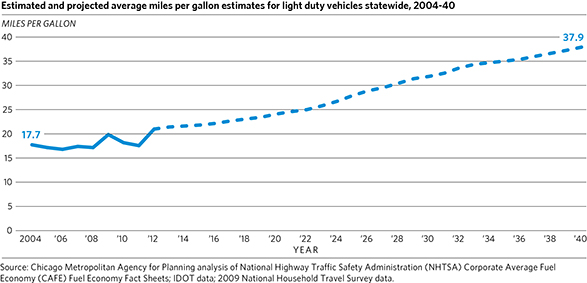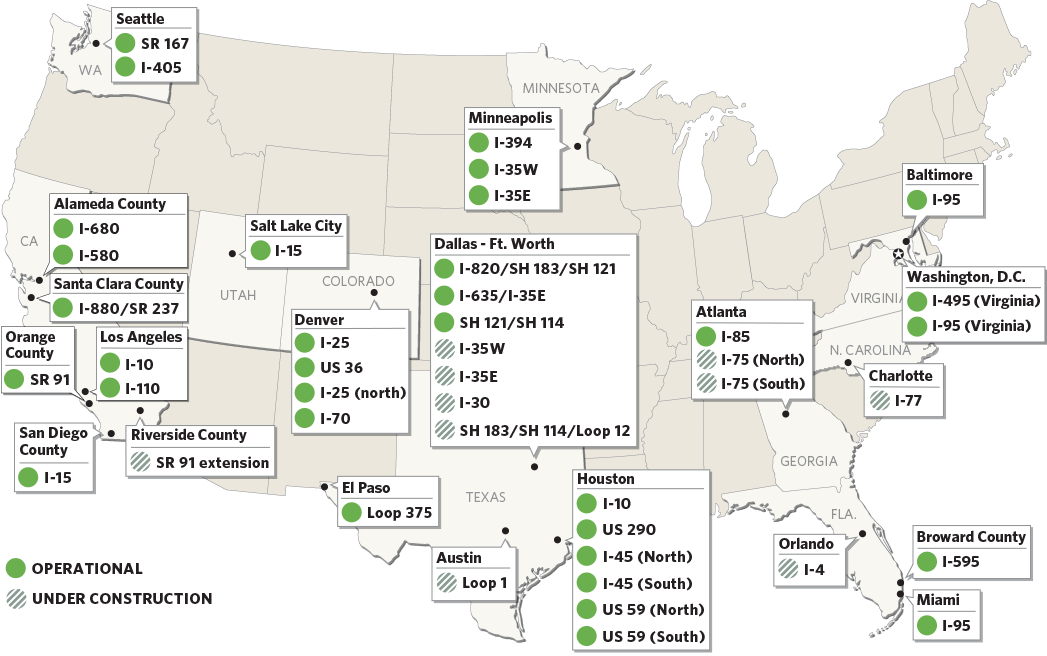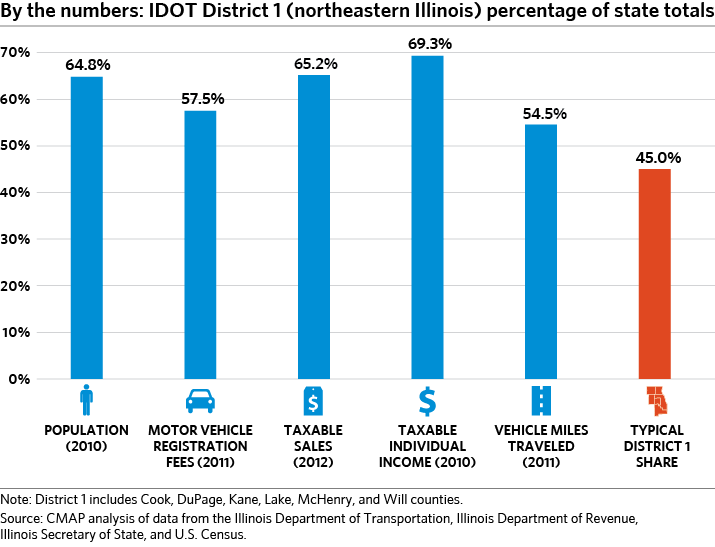In January 2015, CMAP launched an interactive mobility data visualization website that allows users to explore metropolitan Chicago's regional system of roads, transit, and freight, which are not being adequately maintained. Resources to upgrade these assets are more scarce and precious than ever. This is the first in a series of Policy Updates that highlights CMAP efforts to address the region's mobility needs for greater economic prosperity and quality of life. This piece focuses on new revenue sources recommended by the GO TO 2040 comprehensive regional plan to address maintenance, modernization, and expansion needs. Future pieces will examine the economic impacts of freight congestion, and the Chicago Region Environmental and Transportation Efficiency (CREATE) program.
Northeastern Illinois has significant transportation investment needs just to maintain its existing roads, transit, and freight systems. While less than three-quarters of the region's transit assets are in a state of good repair, just three-quarters of the region's highway system is rated as having an acceptable ride quality. Additionally, the region needs to expand and modernize the system to relieve congestion and serve population and job growth. While transportation is still a significant strength of northeastern Illinois, the region must invest in the system to compete with other U.S. and global economic centers. In order to achieve this, the region must enhance its existing funding streams and implement new revenue sources to support transportation investments needed to keep Illinois competitive in a global economy.
In October 2014, the GO TO 2040 comprehensive regional plan was updated in accordance with federal law. Forecasts in the Financial Plan for Transportation indicated that the revenues from existing sources expected to be available over the planning horizon (2015-40) will just minimally exceed the amount necessary to operate, maintain, and administer the transportation system. This will only allow for modest investments to bring the system toward a state of good repair, as well as provide for additional enhancements and expansions to the system. To fiscally constrain desired modernization and expansion activities within the long-range planning context, GO TO 2040 recommends the implementation of new and enhanced sources of reasonably expected transportation revenues:
- State motor fuel tax increase and replacement
- Congestion pricing on new capacity and portions of the existing system
- Performance-based funding
- Variable parking pricing
This Policy Update summarizes why these revenues and policies must be implemented to ensure the future viability of the region's transportation system.
State motor fuel tax increase and replacement
GO TO 2040 recommends that the state motor fuel tax (MFT) rate be increased by 8 cents and indexed to inflation in the short-term and that the MFT be replaced in the long-term. Although the rate has been increased nine times since its 1927 enactment, the state MFT has remained $0.19 per gallon since 1991. As a per-gallon tax, MFT revenues have failed to keep pace with inflation in construction costs over time. The following chart compares growth of state motor fuel tax revenue to growth of inflation and construction costs.

State MFT revenues have declined annually since 2007, when revenues reached a high of $1.4 billion statewide. This can be partially explained by a decline and stabilization in statewide vehicle miles traveled. After growing steadily throughout the 1990s and early 2000s, miles traveled peaked in 2004, but have held fairly steady with periodic declines since then. Additionally, the consumption of motor fuel has declined more steadily and faster than vehicle miles traveled, primarily as a result of rising vehicle fuel economy.
As motor fuel consumption continues to slow and vehicle fuel economy rises, a rate increase and inflationary index will be insufficient to keep revenues growing with the cost of construction. Annual revenue growth of 3.7 percent through 2040 would allow the region to both to maintain the system and make strategic improvements to it. Even with the 8-cent MFT increase and annual inflation adjustment, CMAP forecasts revenue growth to be just 1.7 percent through 2040, again due to improvements in vehicle fuel economy. The following chart illustrates the estimated average statewide vehicle fuel economy since 2004, as well as the projected growth in average fuel economy through 2040.

Ultimately, the MFT needs to be replaced to provide adequate revenue to maintain and operate the transportation system. If the state MFT rate increase and indexing were implemented in 2016, followed by the enactment of a replacement for both state and county MFT revenues in 2025 that includes revenues from the reasonably expected state MFT rate increase, an additional $17.3 billion would be generated.
Congestion pricing on new capacity and portions of the existing system
The implementation of congestion pricing, or "express toll lanes," will help manage traffic and give drivers the option to avoid traffic. Congestion has been increasing 5 percent annually for 30 years, and the average regional commuter spent 71 hours stuck in traffic in 2012. Congestion pricing has existed in the U.S. since 1995, when the SR 91 Express Lanes opened in Orange County, California. Since then, express toll lanes have opened in regions across the country, with currently more than 25 express toll lanes or high occupancy toll facilities operating or under construction in the U.S.
U.S. express toll lane facilities

GO TO 2040 assumes revenues from congestion pricing on a portion of existing expressways would begin to flow to the region in 2020. These revenues are separate from congestion pricing on the new capacity provided via major capital projects, which are incorporated in the public costs of those projects. If congestion pricing on a selection of expressways equivalent to 25 percent of the region's existing expressway network occurred beginning in 2020 and revenue grew at a rate of 3 percent annually, CMAP forecasts that $11.7 billion would be generated.
Performance-based funding
The State of Illinois highway program is subject to a long-standing informal policy that directs 45 percent of transportation funds to northeastern Illinois and the remaining 55 percent downstate. This 55/45 Split is not a law -- it is an agreement established decades ago within the Illinois General Assembly and followed by the Illinois Department of Transportation. The arbitrary formula does not reflect the region's needs and its disproportionate contributions to overall Illinois economic output, population, travel, and tax receipts. This chart shows how northeastern Illinois contributes to the state's economy by five indicators -- each of which is a much higher than 45 percent of the Illinois total.

In contrast to this approach, CMAP recommends that Illinois implement performance-based funding of highway and bridge projects to set transparent priorities for investments in maintaining, modernizing, and expanding our transportation system. While CMAP does not advocate for the implementation of a different arbitrary formula, it is reasonable to assume that the implementation of performance-based funding would result in increased funding for the region, which has the majority of the state's population and economic activity. A 5-percent increase in federal and state highway revenues toward northeastern Illinois would result in a net increase of $8.3 billion over the 2015-40 planning period.
Variable parking pricing
Local governments with commercial areas experiencing high demand for parking could implement variable parking pricing. This strategy is used to balance parking supply and demand by raising prices for parking during peak periods, helping to improve traffic flow and increase the availability of parking. Assuming that an additional 1 percent of off-street parking spaces were priced annually during the planning period and that half of the local revenues generated would be used for local transportation investments, $1.5 billion would be generated between 2015-40.
Moving forward
The region must work collaboratively to protect and enhance its transportation assets. Our financial challenges can become opportunities for bold, cooperative actions to enact these policy changes. By regional leaders and implementers acting in cooperation with one another, the region can ensure the long-term sustainability of the region's transportation system, which is a major contributor to the economy and the livability of northeastern Illinois. CMAP will be pushing for the implementation of these revenues by the Illinois General Assembly, as highlighted in the agency's 2015 state legislative agenda and framework.